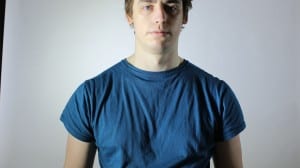Here is the actual final script. Whilst I still used some of the dialogue from the previous full script, it had very little story and logical progression, this script forms the skeleton of the film. It was written using Adobe Story, a software I had never used before, but I wanted to experience using an actual script writer. It was often irritating and confusing to use, and you couldn’t use copy and paste which was very annoying, but it was useful to have a layout which was very easy to read, and I sent the script over to Sam as a pdf, which is below.
17/05/15 – Test shots
The blog site won’t let me upload video clips, so here are two photo test shots I took before two of the filming sessions. The first photo is from the first session, the whole we had to reshoot, and you can see the corner which was caught in the frame. This shot was just for colouring/white balance purposes, which is why Sam isn’t entered in the photo.
The second shot was from the second session, and you can see from the image that the lighting was set up a lot differently. The camera settings were different, and the lights were in different positions. Whilst I think the first is lit better, I think the second is better for my project, and I’m glad we went with that set up. It’s darker, much more contrasting against the background, and I think fits the project better.
Websites
http://www.hexjam.com/uk/living/this-is-what-stock-images-think-depression-looks-like?utm_source=facebook&utm_medium=social&utm_campaign=STBFB
http://www.hexjam.com/uk/campus/23-things-people-with-anxiety-will-understand?utm_source=facebook&utm_medium=social&utm_campaign=STBFB
http://www.vox.com/2014/12/4/7262991/anxiety-disorder-help
Update.
16/05/15 – Sound association
A big idea for my soundscape, and one that I feel makes it different to those I have made in the past, is sound association. In the past, I have heard many people describing their experiences with mental health using colours, sounds, feelings, and I wanted to reflect that within the piece. It was also inspired by the OCD film I found, and the chaotic sound he produced for it.
Due to the fact that I was physically moving the character for the glimpses into his head, it needed it to sound different too. It wasn’t the real world anymore, it was what it sounds like to be in his head.
I chose waves for the ‘upset’ sections, to represent the feeling of drowning, and being overwhelmed to the point of not being able to control it. For anger, I chose heavy traffic – chaotic, often unpleasant, and very distracting – so difficult to sustain coherent thought. And for the ‘depression’ stages, I used a big echoing reverb setting to try and replicate the isolating loneliness which is often felt by those suffering from mental health problems.
16/05/15 – Why the character is called ‘Man’
This wasn’t really something that came from research, I just wanted to have a character that didn’t necessarily identify with anyone specifically. I wanted the character to be accessible to everyone. So, using ‘Man’ is more a reference to the human race, rather than a male.
It was important that the audience didn’t feel like they could never be this character, as the character is supposed to represent the potential in all of us to develop such problems.

